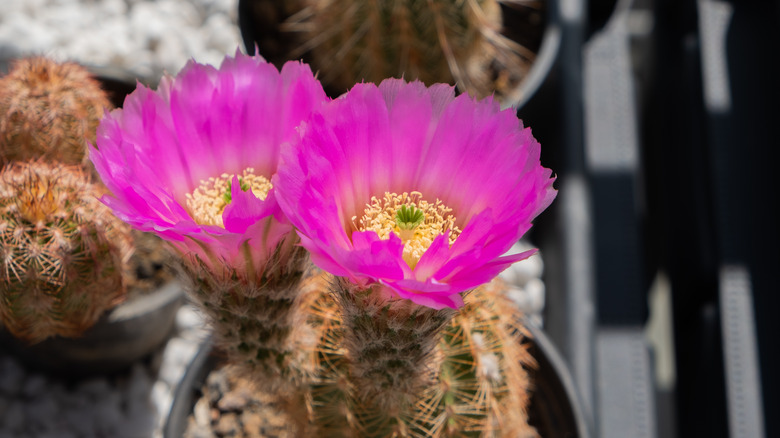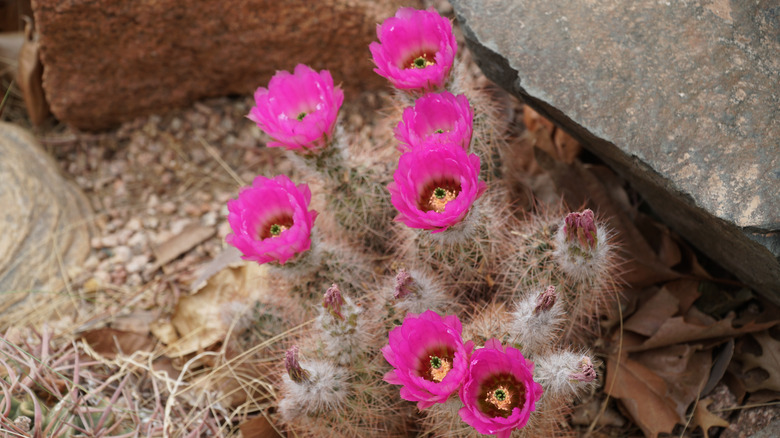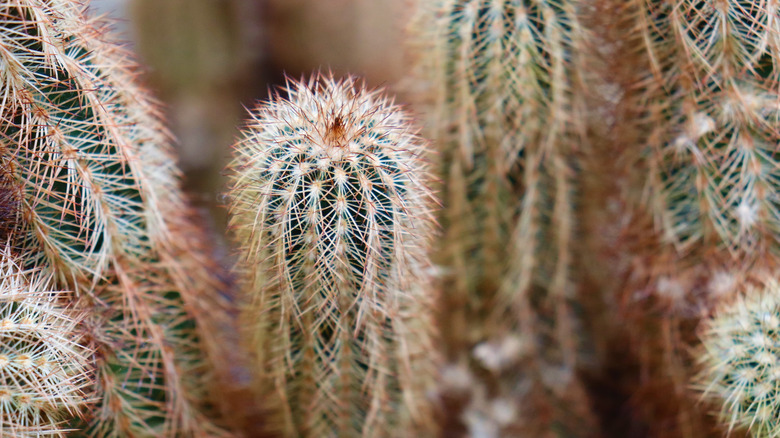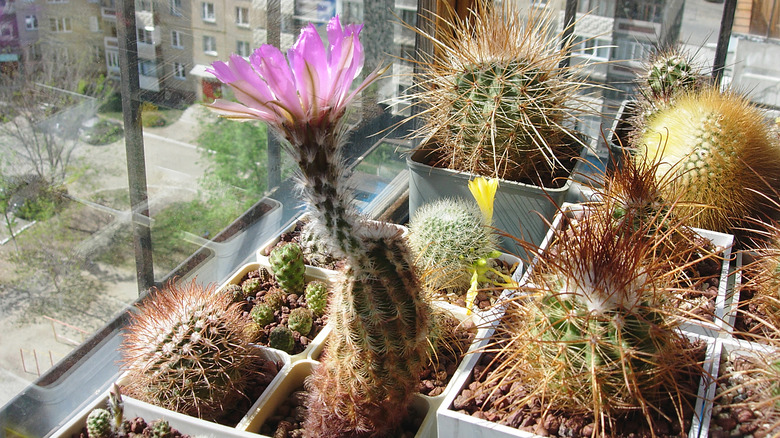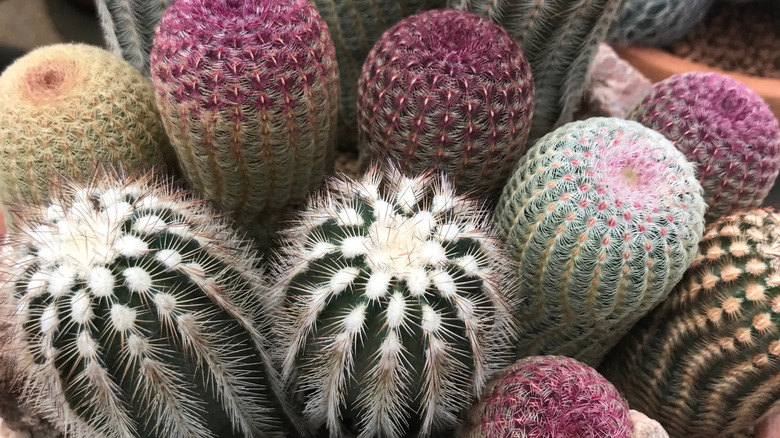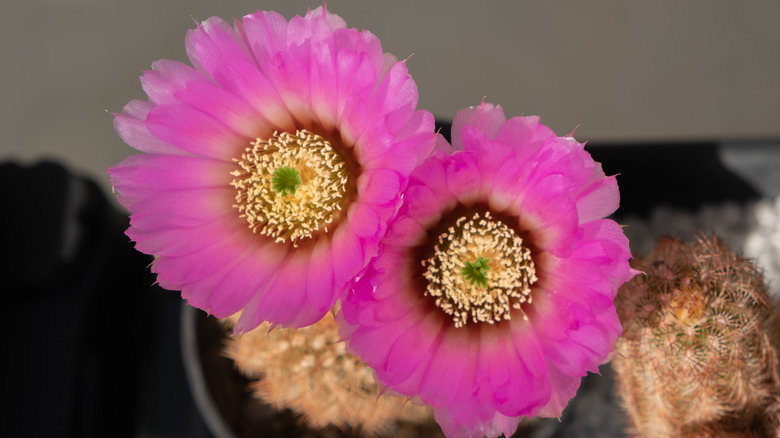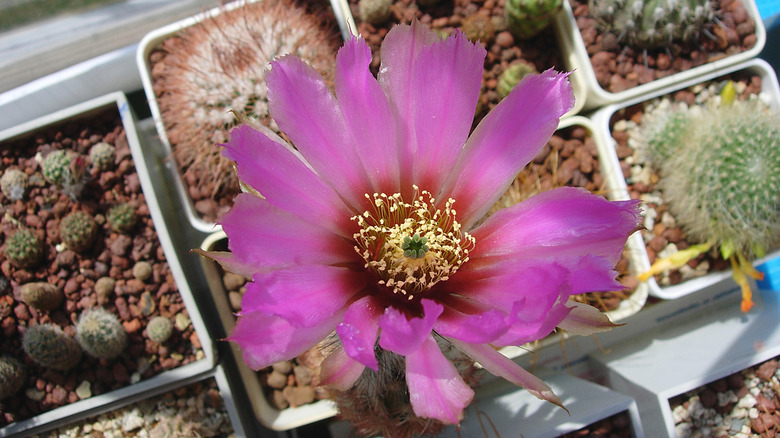How To Care For A Lace Hedgehog Cactus
The lace hedgehog cactus, known scientifically as echinocereus reichenbachii, is a species of cactus belonging to the Echinocereus genus, which blooms with bright pink flowers with a yellow center. According to Cactus Art, the flowering cactus gets its common name from the pattern of its spines, which looks similar to lace.
Found natively in the Southwest region of the United States and the Northeast region of Mexico, this plant grows as a perennial outdoors in the appropriate climate, per The Spruce. The cactus is actually pretty resilient and can withstand cold weather if kept dry. The whole genus of cacti is the same way, surviving USDA hardiness zones as low as 5 and up to 11.
Echinocereus is one of the most popular and easy to care for genus of cacti, and all have similar care needs. Whether you're a cactus fiend or new to the spiky plant, the lace hedgehog cactus is a great starting point.
How to use lace hedgehog cactus in garden
While the lace hedgehog cactus is native to a warmer, arid climate, it is quite adaptable to colder climates. In general, the Echinocereus genus is comfortable in conditions above 50 degrees Fahrenheit, according to The Spruce. The lace hedgehog cactus, in particular, can withstand temperatures as low as 14 degrees Fahrenheit, says Cactus Art. They also don't like to be left wet and prefer full direct sun, which are important things to keep in mind when using it to landscape.
Cacti in the Echinocereus genus tend not to grow that tall. The lace hedgehog cactus is no exception, often only reaching 8 inches in height and 3 inches in width, notes the Lady Bird Johnson Wildflower Center. With that in mind, this cactus won't make for a great feature piece in your garden, but it can definitely be grown in small clusters to fill in gaps. When the flowers bloom in the spring, you'll have the added bonus of the bright pink blooms. Cactus Art recommends growing it in a rock garden or container and planting it alongside a yucca plant, agave plants, and low-growing ground cover flowers.
How to grow lace hedgehog cactus
The lace hedgehog cactus can be grown through both seed germination or propagation, according to World of Succulents. For seed germination, look for seeds once the plant has flowered or purchase them from either an online retailer or plant store. Seed germination may be a little complicated for a few reasons. If grown indoors, the lace hedgehog cactus isn't as likely to bloom as it is outdoors. Seed germination for cacti, in general, isn't easy and requires a lot of patience, so finding seeds may be hard, too.
If you still want to try germination, begin by harvesting or otherwise obtaining your seeds. In a cactus soil mix, add the seeds to a shallow potting medium, and keep them warm and only very slightly damp. Consider tenting the seeds to keep moisture in by covering them in plastic wrap, leaving a gap to let in air. In a couple of weeks, they should sprout.
Propagation is much easier and more reliable. To do this, look for and remove an offset with the roots attached, which will look like a miniature version of the mother plant. Let it dry out and callus over, which can take anywhere from a few days to a couple of weeks, explains The Spruce. Plant the offset in cactus soil, and care for it as usual. Roots should develop within a few weeks. While it usually doesn't like moisture, keep the young plant a little moist until roots grow.
How to care for lace hedgehog cactus
The lace hedgehog cactus is a relatively easy plant to grow and care for, needing minimal maintenance or routine special care. The only issue you may run into is getting the cactus to flower, which may be difficult indoors. As stated earlier, this cactus is quite tolerant of cold temperatures, but for it to thrive, try to keep it at room temperature levels, maybe a little warmer to encourage blooms.
As with most cacti, this plant prefers bright, full, direct sun, both indoors and out, for at least six hours a day, per Gardening Know How. Inside, a south-facing window is ideal, but an east or west-facing window can work, too. Avoid north-facing windows. Water sparingly, only when dry to the touch, as any more could quickly lead to root rot, warns The Spruce. As for fertilizer, feeding your plant with a liquid formula specifically for cacti in the summer will help strengthen the plant, encourage growth, and even help with flowering.
Lace hedgehog cactus varieties
The lace hedgehog cactus belongs to the Echinocereus genus, which includes roughly 75 species of cacti, all with varying taxa, according to World of Succulents. The genus is generally known for being smaller and easier to grow than other cacti, making it both a great houseplant and outdoor plant. They all bear flowers, too, and are a little easier to coax blooms from than other cacti. If you want to give your lace hedgehog cactus a friend and are enjoying the ease of care associated with the Echinocereus genus, here are a few more species to explore, per Succulent Alley.
-
Echinocereus triglochidiatus: With blooms of deep red flowers shaped like cups, this species has multiple subspecies and taxa, which vary in shape, size, and thorniness.
-
Echinocereus fendleri: This species is a low-growing cactus that's unique for its vibrant, deep purple flowers, white spine, and the edible fruit it produces.
-
Echinocereus dasyacanthus: Commonly referred to as the Texas rainbow cactus, this species has alternating bands of spines that can create alternating colors and blooms of yellow flowers.
-
Echinocereus ctenoides: This species flowers with bright, bold red blooms that will make a statement in any garden.
-
Echinocereus carmenensis: These cacti are also known as the chocolate-scented hedgehog due to the chocolate-scented, greenish flowers it produces.
Is the lace hedgehog cactus toxic?
While there are plenty of poisonous cacti out there, the lace hedgehog cactus, and all members of the Echinocereus genus, are completely non-toxic for both humans and pets, according to Garden Beast. That being said, there isn't any proof that the cactus is edible, either.
In fact, you should still be very careful to keep this plant out of reach of pets and children, as it is a spiny cactus, and the thorns can easily become embedded in a paw pad, fur, or skin. The needles from a lace hedgehog cactus shouldn't be a major issue, but they will be annoying and painful, so be sure to wear gloves when handling the plant.
If you or someone else does get stuck with a cactus needle, there are a few tried-and-true tricks to remove them. Tweezers are a good first option to remove a needle or two. But to remove multiple needles at once, 365 Atlanta Traveler recommends applying a layer of liquid glue to the skin, letting it dry completely, and then peeling it off. Removing needles from pets isn't as easy, though, as they may be panicking and difficult to restrain. Do your best to safely restrain them, and then try to remove as many needles as you can with a comb, advises Phoenix Veterinary Center. Then, use tweezers to remove other needles as gently as possible. Call your vet if there are needles too deep to remove on your own.
How to repot lace hedgehog cactus
The lace hedgehog cactus doesn't need frequent repotting, notes The Spruce, as it is relatively slow-growing and also has a shallow root system. However, if you notice the plant stem itself is growing too heavy for its current pot, or roots are growing through the pot's drainage holes, it's time to repot.
To begin, look for a pot an inch or so larger than its current pot, preferably with multiple drainage holes and unglazed to help it drain quicker. It should also be shallow to match the root system. You will also need a bag of either cactus soil mix or a super well-draining soil with sand mixed in.
With gloved hands, gently slide the cactus out of its current pot, being gentle to avoid breaking weak roots. Dust off as much old dirt as possible. Add a little bit of soil to the new pot, and add the cactus at the same depth as it was in its old pot. Fill with soil, and only water a little bit to bind the soil.
